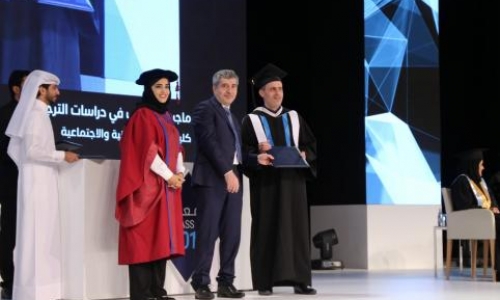Quality Assessment in Translation

A quest for a gold standard in Arabic translation and quality among the focus areas at the College of Humanities and Social Sciences' Khetam awards ceremony.
“Arabic is impossibly difficult to learn;” despite relentless attempts to dispel the long-held belief that Modern Standard Arabic (also known as fusha) is unlikely to be easily absorbed by non-native speakers, linguists agree that Arabic is no different than any other language when it comes to conjugation, form, and pronunciation.
The UN’s classification of Arabic as the fifth most widely spoken language in the world is not just population-based. The 2019 Ethnologue -- a reference publication on living languages of the world -- estimates that nearly 273 million people have adopted Arabic as a second language, rendering it the third most popular language in this category worldwide.
Despite its popularity, translators and linguists generally concur that there is a lack of tools to standardize, uplift, and assess Arabic language translation quality -- an area that has not received due attention in academia. This, among others, was a subject addressed by an awardee of the College of Humanities and Social Sciences’ Khetam (culmination) ceremony.
“Translation quality assessment has only recently begun to garner considerable attention, particularly at the end of the 20th and the beginning of the 21st centuries,” said Ahmed Ghaly, a graduate of the College of Humanities and Social Sciences’ Master of Arts in Translation Studies, which is delivered by the Translation and Interpreting Institute. Ghaly is also the recipient of other Khetam awards, including the Outstanding Thesis and Most Likely to Become a Professor awards.
Need More Tools
One solution to achieve a measurable translation assessment tool, based on Ghaly’s studies, could be to consider House’s revised Translation Quality Assessment Model - which is perceived to be the world’s best-known model for gauging the quality of translation - in its various applications to the Arabic language.
The Model of Translation Quality Assessment introduced by renowned German translation scholar Juliane House in 1977 is one of the most objective yet controversial means of assessing the quality of translation. It is based on stylistics and discourse analysis and pragmatic theories of language use developed by Prague school -- an influential group of linguists. The model is built on the premise of functional equivalence with a primary focus on preserving the meaning of language across the source text and its target text across the semantic, pragmatic, and textual levels.
“Another is to apply the widely adopted principles of ISO 704: 2009 on terminology formation as a methodology for addressing term-related issues,” he explained.
The International Organization for Standardization (ISO) is a standard-setting body composed of representatives from various national organizations. The ISO’s remit is to promote worldwide proprietary, industrial and commercial standards. Applications of the ISO in Arabic-language translation provides a more consistent framework for translation quality assessment and evaluation.
Inevitably, translation tools will continue to benefit from an association with artificial intelligence technologies -- an area that is quickly seeping into many industries worldwide. “The advent of artificial intelligence and machine translation necessitates that translators keep up with the needs of their time. Awareness of the latest advancements, regularly honing skills, and widening knowledge to encompass many other disciplines are no longer optional,” explained Ghaly.
Setting the Standard
“This research is a valuable and much-needed contribution to academia on translation quality assessment, especially in English-Arabic translation studies. The study is important in terms of two components: translation analysis and commentary,” said Dr. Ashraf Abdel Fattah, assistant professor at the Translation and Interpreting Institute within the College of Humanities and Social Sciences and Ghaly’s thesis advisor. Additionally, it is particularly responsive to the fact that there is a dearth of studies in this area.
The College of Humanities and Social Sciences has recently launched its first-ever Doctor of Philosophy (PhD) in Humanities and Social Sciences program -- a degree so uniquely designed to cultivate a multidisciplinary education and encourage an inquisitive approach to learning.
The college has been playing an increasingly important role in supporting a growing community of translators and language experts both locally and regionally.








